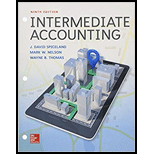
a)
Statement of
Journal: Journal is the method of recording monetary business transactions in chronological order. It records the debit and credit aspects of each transaction to abide by the double-entry system.
Rules of Debit and Credit:
Following rules are followed for debiting and crediting different accounts while they occur in business transactions:
- Debit, all increase in assets, expenses and dividends, all decrease in liabilities, revenues and stockholders’ equities.
- Credit, all increase in liabilities, revenues, and stockholders’ equities, all decrease in assets, expenses.
To Journalize: The transactions to deduce the missing amounts.
b)
To Prepare: The statement of retained earnings for Company B.
Want to see the full answer?
Check out a sample textbook solution
Chapter 21 Solutions
INTERMEDIATE ACCOUNTING(LL)-W/CONNECT
- I need guidance on solving this financial accounting problem with appropriate financial standards.arrow_forwardI need help with this financial accounting problem using proper accounting guidelines.arrow_forwardCan you help me solve this financial accounting problem with the correct methodology?arrow_forward
- Can you help me solve this general accounting question using valid accounting techniques?arrow_forwardBarnett's Bottles uses the number of hours in its molding machines to allocate overhead costs to products. In a typical month, 3,800 molding hours are expected, and the average monthly overhead costs are $7,600. During March, 4,100 molding hours were used, and total overhead costs were $7,950. Required: Compute Barnett's predetermined overhead rate and the amount of applied overhead for March. Round your answers to the nearest cent.arrow_forwardCan you explain this general accounting question using accurate calculation methods?arrow_forward
- Please provide the solution to this financial accounting question using proper accounting principles.arrow_forwardDaniels Corporation applies manufacturing overhead to products based on standard direct labor-hours. The budgeted fixed manufacturing overhead cost for the most recent quarter was $37,500, and the actual fixed manufacturing overhead cost for the quarter was $38,200. The company based its original budget on 7,500 direct labor-hours. The standard hours allowed for the actual output of the quarter totaled 7,100 direct labor-hours. a. What was the overall fixed manufacturing overhead budget variance for the quarter? b. What was the fixed overhead rate? c. What was the volume variance?arrow_forwardScenario: The Redmond Management Association held its annual public relations luncheon in April Year 2. Based on the previous year’s results, the organization allocated $25,290 of its operating budget to cover the cost of the luncheon. To ensure that costs would be appropriately controlled, you, the treasurer, prepared the following budget for the Year 2 luncheon. Using Excel—showing all work and formulas—to complete the following I need help with a flexible budget. Computing the sales volume variance and the variable cost volume variances based on a comparison between the master budget and the flexible budget. Computing flexible budget variances by comparing the flexible budget with the actual results.arrow_forward
 Cornerstones of Financial AccountingAccountingISBN:9781337690881Author:Jay Rich, Jeff JonesPublisher:Cengage Learning
Cornerstones of Financial AccountingAccountingISBN:9781337690881Author:Jay Rich, Jeff JonesPublisher:Cengage Learning
